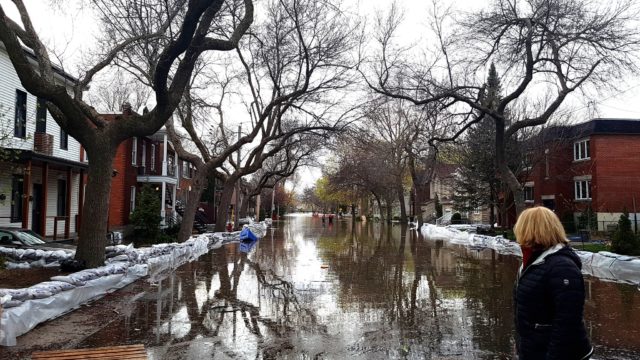The past 12 months have brought the reality of the climate emergency to the front door of people across Canada. Since this time last year, Canadians have experienced killer heatwaves, disastrous flooding and choking wildfires.
In the midst of this climate chaos, it can be hard to remember that the passage of the Canadian Net-Zero Emissions Accountability Act (NZEAA) in June 2021 was cause to celebrate. The law establishes the legal foundation Canada has needed to bring consistency to climate governance, to ensure we never miss another climate target and put the country on a path to a net-zero future.
That said, implementing NZEAA effectively was always going to be the true test of Canada’s resolve. The inaugural climate plan, mandated by the new legislation, known as the Emissions Reduction Plan (ERP), is the first piece of the NZEAA’s accountability mechanism to take shape.
Canada’s climate target
The federal government has set Canada’s climate target for 2030 as a 40-45 per cent emissions reduction from 2005 levels. Canada has never achieved a climate target, and without clear, bold and ambitious planning, it will struggle to hit this one too.
To achieve Canada’s emissions goals and meet the requirements of Canada’s newest climate law, the ERP must represent an overhaul of Canadian climate planning. We cannot stress this enough: if the ERP is simply one of our old and impenetrable climate plans, rejigged to the new 2030 target, it will fail to satisfy the requirements of NZEAA and to provide the clear guidance required in a time of climate chaos.
Ecojustice, our partner organizations, climate activists and people across Canada pushed political leaders for a strong climate law that resulted in NZEAA. The focus of the new law is the year 2050, by which point Canadian emissions must be “net-zero” or less. This means that by the year 2050, and every year after, human-made emissions must be cancelled out or balanced by humans taking necessary actions to remove those emissions.
2050 means action now
2050 might appear like a long time off, but this is no easy task. Wide-ranging policies and plans implemented during the last five or so years have only just stopped Canada’s emissions from increasing.
NZEAA can be the tool for Canada to meet the challenging task of achieving net-zero emissions by 2050. It does two important things.
First, it requires the government to set national emissions reductions targets on an ambitious path to the goal of net zero emissions by 2050 based on the best available science. The first target is set for 2030, the next will be for 2035, then 2040 and 2045. This provides shorter-term goals to help set us on the right path to reach that distant 2050 target. Second, it requires the government to set about meeting those regular targets with immediate ambition, transparency, and accountability.
All three of those words — ambition, transparency, accountability — are used so frequently in relation to government action that they can feel meaningless. NZEAA itself does a lot of work to translate those ideals into practical elements, illustrated here.
But the how of each of these elements is as important as the fact of their existence. That is why the forthcoming ERP is so important.
Ecojustice has made nine key recommendations, in consultation with our partners Climate Action Network, West Coast Environmental Law and Equiterre, falling into four categories.
The modelling underpinning the emissions reductions measures in the plan
First, modelling is central to reaching our climate targets. The core Canadian climate models are used by all levels of government and the private sector to inform decisions, so the futures they define end up strongly shaping policy decisions.
Our recommendations ask the modellers to ground their work in a 1.5 degree Celsius world, not the world of destructive oil demand, harmonize their work so that they are speaking the same language, and come up with a plan to ensure they can explain to each other, and the Canadian public, why they sometimes reach different conclusions. In other words, to ensure that our models are as robust as possible.
In addition, the authors of the plan have to be transparent, showing Canadians the assumptions behind the modelling, so that those assumptions can be challenged and tested.
The structure and format of the plan
Secondly, NZEAA set the 2050 target and committed to use accountability to reach it and the milestone targets along the way. Accountability must be built into every element of this framework, down to the structure and format of the ERP itself.
The elements of the plan must be trackable and “SMART” —specific, measurable, audience-specific, realistic and time-bound — so that the Canadian public can easily assess their progress. If the ERP looks like previous climate plans, which bury the actual measures in so much text that even the most dedicated reader can barely make out what is what, the ERP will surely fail to meet the NZEAA.
Data collection, analysis and synthesis
Thirdly, the problem of climate change is complicated, detailed, and crosses every discipline: physical sciences, energy systems, economics, social sciences, political science. We know there are significant data gaps that impact how we assess and address climate change.
Data collection must improve, and the ERP must acknowledge and plan to fill the gaps. The data must not only be complete, but it also must be understandable. We know that there are better ways to talk about climate change, ways that cut across jargon and communicate the true nature of the problem, and the solutions, to Canadians. The ERP must take a page from international best practices and use and develop those communication tools, or indicators.
The necessary immediate and ambitious action that should be outlined in the plan
Lastly, Canada’s goal of net-zero GHG emissions by 2050 is fundamentally tied to safe levels of warming: 1.5 degrees Celsius. NZEAA, and our international obligations, recognize that limiting climate change to 1.5 degrees Celsius requires immediate and ambitious action. The ERP must use as ambitious a target as possible.
The current range of 40-45 per cent below 2005 levels must be treated as 45 per cent at a minimum in the ERP — in fact that target still falls far short of Canada’s fair share, which is at least 60 per cent below 2005 levels.
The interim objective for 2026 in the ERP must be ambitious in and of itself. And the ERP must clearly explain how its measures and strategies will put Canada on an ambitious pathway to reaching the 2050 net-zero goal.
Time for ambitious action
The climate emergency is more real for people across Canada than ever before. Political leaders must produce an ERP that matches the urgency of the situation. We hope that the government will continue to engage with the public on this key issue, and will share any further opportunities here.
In the meantime, Ecojustice will, as always, continue to push those in power to be bold and ambitious to chart a path to a safe and sustainable climate future.






